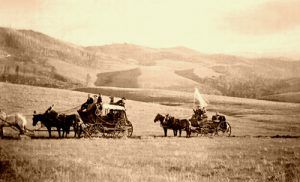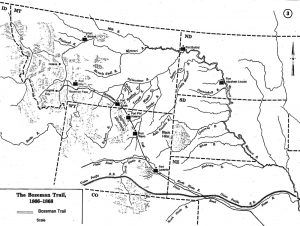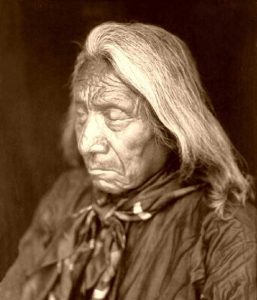Of all the overland trails blazed during the westward movement, the Bozeman Trail ranks as one of the most violent, contentious, and ultimately failed experiments in American frontier history.
Though the trail is named after John Bozeman, an immigrant from Georgia who was said to have blazed the route, Native Americans have been using the route as a travel corridor for centuries. In 1863, Bozeman and partner John Jacobs widened this corridor as a wagon road. They followed in much the same footsteps as Captain William Raynolds had four years earlier in a mapping and exploration expedition for the Army Corps of Topographic Engineers.
The impetus for the trail was a shortcut to goldfields in and around Virginia City, Montana territory. The Bozeman route left the Oregon Trail in central Wyoming, skirted the Bighorn Mountains, crossed several rivers, including the Bighorn, and traversed mountainous terrain into western Montana.
The trail had several advantages, including an abundant water supply and the most direct route to the goldfields.
It also had one major drawback: it cut through the heart of the territory promised to several Indian tribes by the Treaty of Fort Laramie in 1848. This included the rich hunting grounds of the Powder River Country, claimed by the Sioux and other tribes.
The first emigrant trains began traveling up the trail shortly after Bozeman and Jacobs had finished marking the route. In 1864, a large train of 2,000 settlers successfully made the trek. This was the high watermark of travel along the corridor. Though some wagon trains were successful, they were under constant threat of attack. Over the next two years, travel along the corridor stopped because of numerous raids by a coalition of tribes.
Pressure was then placed upon the U.S. government to protect travelers. In 1866, U.S. Army troops were dispatched to construct three forts along the trail, supposedly offering protection to wagon trains. These posts, running from south to north, were Forts Reno, Phil Kearny, and C.F. Smith. Ominously, each of these forts was named after a general who had died during the just-completed Civil War.
In effect, the Bozeman Trail had become a military road. The protection afforded by the U.S. Army’s presence enraged the tribes and began a two-year conflict known as Red Cloud’s War. Under the leadership of Lakota Chief Red Cloud, raids and ambushes were carried out against soldiers, civilians, supply trains, and anyone else brave enough to attempt the trail.
These attacks culminated in three famous incidents. The Fetterman Massacre, in December 1866, saw an army detachment of 79 soldiers and two civilians led by Captain William Fetterman lured from Fort Phil Kearny and utterly destroyed within a few miles of the fort. On August 1, 1867, the Hayfield Fight, where 19 soldiers and six civilians detailed for guard and hay-cutting duty, were attacked. Under siege for over eight hours, they managed to hold off 500 warriors until help arrived. The Wagon Box Fight, where a detachment of 31 soldiers was sent out to guard a team of woodcutters, was encircled yet fought off numerous attacks over five hours from hundreds of warriors.
Continued raids and skirmishes were the rule that proved peace was a rare and evasive exception. Lifeguarding the trail was a combination of tension, monotony, and loneliness. Low morale led to numerous desertions, soldiers on the verge of mutiny, and even cases of insanity at the most isolated outpost, Fort C.F. Smith.
With few, if any, emigrants using the trail, the army sequestered behind fortress walls, and tribes showing few signs of easing up on attacks, the United States government decided to pursue a peace policy. The second (1868) Fort Laramie Treaty recognized the Powder River Country again as the hunting territory of the Lakota and their allies. A presidential proclamation was issued to abandon the forts. The Bozeman Trail was history. For the first time, the United States government had lost a war.
Compiled Kathy Weiser/Legends of America, updated April 2024.
Also See:
Adventures in the American West
Adventures on the Bozeman Trail
Tales and Trails of the American Frontier
Source: National Park Service



